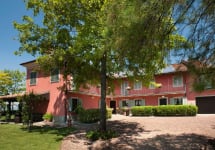Pio Cesare Barolo 2017
-
James
Suckling -
Robert
Parker -
Wine &
Spirits -
Tasting
Panel -
Wine
Enthusiast



Product Details
Your Rating
Somm Note
Winemaker Notes
A classic style Barolo. Excellent structure, harmony, elegance. Soft tannins and balanced fruit. Approachable, but with a very long ageing potential. Barolo is such a great wine which should not be described as a “basic” or “regular” Barolo, simply because it does not have any additional indication on the label.
Professional Ratings
-
James Suckling
Plenty of blackberry and black cherry on the nose with violet and lavender undertones. Full-bodied with powerful tannins that flow across the palate. Ever enveloping and imposing, yet polished and impressive.
-
Robert Parker's Wine Advocate
This is the wine to buy in commemoration of the 140th anniversary (1881-2021) of the historic house of Pio Cesare. The most traditional and classic of the wines in this important portfolio, the 2017 Barolo is packaged in a retro label that speaks to all the grandeur of this important Italian wine appellation. The wine imparts delicate and fine tones of wild fruit, cassis, tar, smoke and crushed rose. The wine is buttoned up and straitlaced, especially now in its youth.
Rating: 94(+) -
Wine & Spirits
Produced with fruit from five different communes, this wine shows good balance and concentration, its bold black- cherry flavors underlined by notes of graphite and firm, muscular tannins. Warm spice notes linger on the extended finish.
-
Tasting Panel
-
Wine Enthusiast
Aromas of dark skinned berry, underbrush and oak-driven spice mingle with camphor. On the full-bodied palate, notes of licorice and espresso accent a core of juicy black cherry before an almost salty close. Firm, fine-grained tannins provide ample support. Drink 2022-2029.
Other Vintages
2020-
James
Suckling -
Robert
Parker -
Wine
Spectator
-
Robert
Parker -
James
Suckling -
Jeb
Dunnuck -
Wine
Spectator
-
James
Suckling -
Robert
Parker - Decanter
-
Wine
Enthusiast -
Wine
Spectator
-
Wine
Enthusiast -
Robert
Parker -
James
Suckling -
Jeb
Dunnuck -
Wilfred
Wong - Decanter
-
James
Suckling - Decanter
-
Robert
Parker -
Wine &
Spirits -
Wine
Enthusiast -
Jeb
Dunnuck -
Wine
Spectator
-
James
Suckling -
Robert
Parker -
Wine
Spectator -
Wine
Enthusiast -
Wine &
Spirits
-
Robert
Parker -
Wine
Enthusiast -
James
Suckling -
Wine
Spectator - Decanter
-
James
Suckling -
Robert
Parker -
Wine
Spectator -
Wine
Enthusiast -
Wine &
Spirits
-
James
Suckling -
Robert
Parker
-
Robert
Parker -
James
Suckling -
Wine
Enthusiast -
Wine &
Spirits -
Wine
Spectator
-
Robert
Parker -
James
Suckling
-
Wine
Enthusiast -
Robert
Parker -
Wine
Spectator
-
Wine
Enthusiast -
Robert
Parker -
James
Suckling -
Wine
Spectator
-
Robert
Parker -
Wine
Enthusiast -
Wine
Spectator -
James
Suckling
-
Wine
Spectator -
Robert
Parker -
Wine
Enthusiast
-
James
Suckling -
Wine
Spectator -
Wine
Enthusiast
-
Wine
Spectator -
Robert
Parker
-
Wine
Spectator -
Robert
Parker
-
Wine
Spectator
-
Wine
Spectator -
Robert
Parker

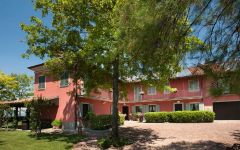
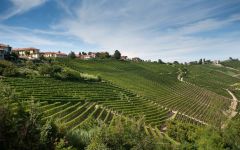
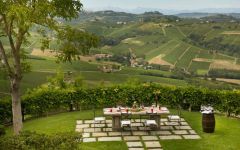
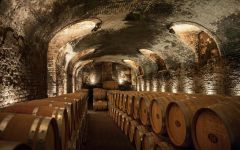


Pio Cesare has been producing wine for more than 100 years and through generations. The tradition began in 1881, when Pio Cesare started gathering grapes in his vineyards and purchasing those of some selected and reliable farmers in the hills of Barolo and Barbaresco districts.
At Pio Cesare, there has always been a conviction that great wine can come only from the finest grapes and the winery's output has always been limited through adherence to the highest standards. Pio Cesare limits its production by using only the most mature and healthy grapes. The ripening of the grapes is carefully monitored and the harvest is rigidly controlled with each grape selected by hand.
Today, the estate is managed by Pio Boffa, great-grandson of Pio Cesare. Under his stewardship, the wines of Pio Cesare have become famous throughout the world. Great strides have been made in quality, and single vineyard offerings have dazzled the wine press.

Responsible for some of the most elegant and age-worthy wines in the world, Nebbiolo, named for the ubiquitous autumnal fog (called nebbia in Italian), is the star variety of northern Italy’s Piedmont region. Grown throughout the area, as well as in the neighboring Valle d’Aosta and Valtellina, it reaches its highest potential in the Piedmontese villages of Barolo, Barbaresco and Roero. Outside of Italy, growers are still very much in the experimentation stage but some success has been achieved in parts of California. Somm Secret—If you’re new to Nebbiolo, start with a charming, wallet-friendly, early-drinking Langhe Nebbiolo or Nebbiolo d'Alba.

The center of the production of the world’s most exclusive and age-worthy red wines made from Nebbiolo, the Barolo wine region includes five core townships: La Morra, Monforte d’Alba, Serralunga d’Alba, Castiglione Falletto and the Barolo village itself, as well as a few outlying villages. The landscape of Barolo, characterized by prominent and castle-topped hills, is full of history and romance centered on the Nebbiolo grape. Its wines, with the signature “tar and roses” aromas, have a deceptively light garnet color but full presence on the palate and plenty of tannins and acidity. In a well-made Barolo wine, one can expect to find complexity and good evolution with notes of, for example, strawberry, cherry, plum, leather, truffle, anise, fresh and dried herbs, tobacco and violets.
There are two predominant soil types here, which distinguish Barolo from the lesser surrounding areas. Compact and fertile Tortonian sandy marls define the vineyards farthest west and at higher elevations. Typically the Barolo wines coming from this side, from La Morra and Barolo, can be approachable relatively early on in their evolution and represent the “feminine” side of Barolo, often closer in style to Barbaresco with elegant perfume and fresh fruit.
On the eastern side of the Barolo wine region, Helvetian soils of compressed sandstone and chalks are less fertile, producing wines with intense body, power and structured tannins. This more “masculine” style comes from Monforte d’Alba and Serralunga d’Alba. The township of Castiglione Falletto covers a spine with both soil types.
The best Barolo wines need 10-15 years before they are ready to drink, and can further age for several decades.
